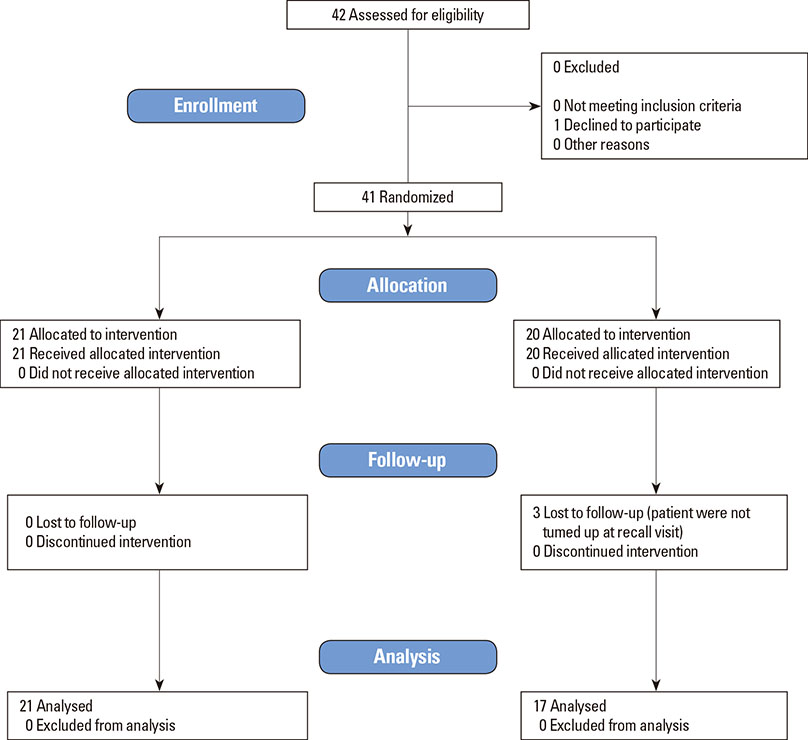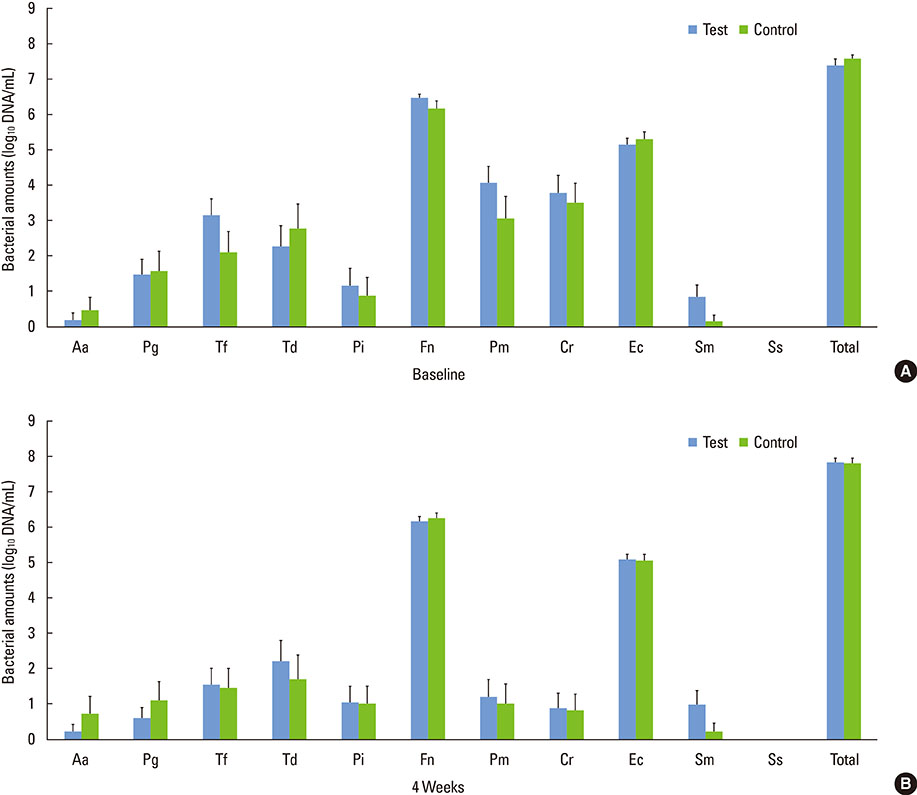J Periodontal Implant Sci.
2014 Dec;44(6):280-287. 10.5051/jpis.2014.44.6.280.
Effects of adjunctive daily phototherapy on chronic periodontitis: a randomized single-blind controlled trial
- Affiliations
-
- 1Department of Periodontology, Ewha Womans University Mokdong Hospital, Seoul, Korea. ekpang@ewha.ac.kr
- 2Department of Oral and Maxillofacial Surgery, Ewha Womans University Medical Center, Seoul, Korea.
- 3Department of Periodontology, Ewha Womans University Graduate School of Medicine, Seoul, Korea.
- KMID: 1820400
- DOI: http://doi.org/10.5051/jpis.2014.44.6.280
Abstract
- PURPOSE
The purpose of this randomized single-blind controlled trial was to elucidate the clinical and antimicrobial effects of daily phototherapy (PT) as an adjunct to scaling and root planing (SRP) in patients with chronic periodontitis.
METHODS
The study was conducted from December 2013 to May 2014 at Ewha Womans University Mokdong Hospital, Seoul, Korea. Forty-one patients with mild to moderate chronic periodontitis were randomly divided into two therapeutic groups in a 1:1 ratio: SRP+PT and SRP (control) groups. All participants underwent full-mouth SRP. PT was performed thrice a day for a month by using electric toothbrushes with embedded light-emitting diodes. Plaque index, gingival index, probing pocket depth (PPD), clinical attachment level (CAL), and bleeding on probing were assessed before (baseline) and four weeks after (follow-up) the treatment. Aggregatibacter actinomycetemcomitans, Porphyromonas gingivalis, Tannerella forsythia, Treponema denticola, Prevotella intermedia, Fusobacterium nucleatum, Parvimonas micra, Campylobacter rectus, Eikenella corrodens, Streptococcus mutans, and Streptococcus sobrinus levels were detected by a real-time polymerase chain reaction at the same points in time.
RESULTS
The clinical parameters improved in both the groups. At the follow-up assessment, PPD was significantly decreased in the SRP+PT group (P=0.00). Further, PPD and CAL showed significantly greater changes in the SRP+PT group than in the SRP group (PPD, P=0.03; CAL, P=0.04). P. gingivalis and T. forsythia levels decreased in this group, but no significant intergroup differences were noted.
CONCLUSIONS
Adjunctive PT seems to have clinical benefits, but evidence of its antimicrobial effects is not sufficient. Long-term studies are necessary to develop the most effective PT protocol and compare the effectiveness of PT with and without exogenous photosensitizers.
Keyword
MeSH Terms
-
Aggregatibacter actinomycetemcomitans
Campylobacter rectus
Chronic Periodontitis*
Dental Scaling
Eikenella corrodens
Female
Follow-Up Studies
Forsythia
Fusobacterium nucleatum
Hemorrhage
Humans
Korea
Periodontal Index
Periodontitis
Photochemotherapy
Photosensitizing Agents
Phototherapy*
Porphyromonas gingivalis
Prevotella intermedia
Real-Time Polymerase Chain Reaction
Root Planing
Seoul
Streptococcus mutans
Streptococcus sobrinus
Treponema denticola
Photosensitizing Agents
Figure
Reference
-
1. Renvert S, Dahlen G, Wikstrom M. Treatment of periodontal disease based on microbiological diagnosis: relation between microbiological and clinical parameters during 5 years. J Periodontol. 1996; 67:562–571.
Article2. Haffajee AD. Systemic antibiotics: to use or not to use in the treatment of periodontal infections: that is the question. J Clin Periodontol. 2006; 33:359–361.
Article3. Darveau RP, Tanner A, Page RC. The microbial challenge in periodontitis. Periodontol 2000. 1997; 14:12–32.
Article4. Soukos NS, Goodson JM. Photodynamic therapy in the control of oral biofilms. Periodontol 2000. 2011; 55:143–166.
Article5. Diamond I, Granelli SG, McDonagh AF, Nielsen S, Wilson CB, Jaenicke R. Photodynamic therapy of malignant tumours. Lancet. 1972; 2:1175–1177.
Article6. Braun A, Dehn C, Krause F, Jepsen S. Short-term clinical effects of adjunctive antimicrobial photodynamic therapy in periodontal treatment: a randomized clinical trial. J Clin Periodontol. 2008; 35:877–884.
Article7. Ge L, Shu R, Li Y, Li C, Luo L, Song Z, et al. Adjunctive effect of photodynamic therapy to scaling and root planing in the treatment of chronic periodontitis. Photomed Laser Surg. 2011; 29:33–37.
Article8. Sigusch BW, Pfitzner A, Albrecht V, Glockmann E. Efficacy of photodynamic therapy on inflammatory signs and two selected periodontopathogenic species in a beagle dog model. J Periodontol. 2005; 76:1100–1105.
Article9. O'Neill JF, Hope CK, Wilson M. Oral bacteria in multi-species biofilms can be killed by red light in the presence of toluidine blue. Lasers Surg Med. 2002; 31:86–90.10. Soukos NS, Socransky SS, Mulholland SE, Lee S, Doukas AG. Photomechanical drug delivery into bacterial biofilms. Pharm Res. 2000; 17:405–409.11. Balata ML, Andrade LP, Santos DB, Cavalcanti AN, Tunes Uda R, Ribeiro Edel P, et al. Photodynamic therapy associated with full-mouth ultrasonic debridement in the treatment of severe chronic periodontitis: a randomized-controlled clinical trial. J Appl Oral Sci. 2013; 21:208–214.
Article12. Andersen R, Loebel N, Hammond D, Wilson M. Treatment of periodontal disease by photodisinfection compared to scaling and root planing. J Clin Dent. 2007; 18:34–38.13. Betsy J, Prasanth CS, Baiju KV, Prasanthila J, Subhash N. Efficacy of antimicrobial photodynamic therapy in the management of chronic periodontitis: a randomized controlled clinical trial. J Clin Periodontol. 2014; 41:573–581.
Article14. Fukui M, Yoshioka M, Satomura K, Nakanishi H, Nagayama M. Specific-wavelength visible light irradiation inhibits bacterial growth of Porphyromonas gingivalis. J Periodontal Res. 2008; 43:174–178.
Article15. de Almeida JM, Theodoro LH, Bosco AF, Nagata MJ, Oshiiwa M, Garcia VG. Influence of photodynamic therapy on the development of ligature-induced periodontitis in rats. J Periodontol. 2007; 78:566–575.
Article16. Smalley JW, Birss AJ, Withnall R, Silver J. Interactions of Porphyromonas gingivalis with oxyhaemoglobin and deoxyhaemoglobin. Biochem J. 2002; 362(Pt 1):239–245.
Article17. Soukos NS, Som S, Abernethy AD, Ruggiero K, Dunham J, Lee C, et al. Phototargeting oral black-pigmented bacteria. Antimicrob Agents Chemother. 2005; 49:1391–1396.
Article18. Silness J, Loe H. Periodontal disease in pregnancy. II: correlation between oral hygiene and periodontal condtion. Acta Odontol Scand. 1964; 22:121–135.
Article19. Löe H. The gingival index, the plaque index and the retention index systems. J Periodontol. 1967; 38:Suppl.
Article20. Ainamo J, Bay I. Problems and proposals for recording gingivitis and plaque. Int Dent J. 1975; 25:229–235.21. de Almeida JM, Theodoro LH, Bosco AF, Nagata MJ, Bonfante S, Garcia VG. Treatment of experimental periodontal disease by photodynamic therapy in rats with diabetes. J Periodontol. 2008; 79:2156–2165.
Article22. Christodoulides N, Nikolidakis D, Chondros P, Becker J, Schwarz F, Rössler R, et al. Photodynamic therapy as an adjunct to non-surgical periodontal treatment: a randomized, controlled clinical trial. J Periodontol. 2008; 79:1638–1644.
Article23. Polansky R, Haas M, Heschl A, Wimmer G. Clinical effectiveness of photodynamic therapy in the treatment of periodontitis. J Clin Periodontol. 2009; 36:575–580.
Article24. Theodoro LH, Silva SP, Pires JR, Soares GH, Pontes AE, Zuza EP, et al. Clinical and microbiological effects of photodynamic therapy associated with nonsurgical periodontal treatment. A 6-month follow-up. Lasers Med Sci. 2012; 27:687–693.
Article25. Pourabbas R, Kashefimehr A, Rahmanpour N, Babaloo Z, Kishen A, Tenenbaum HC, et al. Effects of photodynamic therapy on clinical and gingival crevicular fluid inflammatory biomarkers in chronic periodontitis: a split-mouth randomized clinical trial. J Periodontol. 2014; 85:1222–1229.
Article26. Bassir SH, Moslemi N, Jamali R, Mashmouly S, Fekrazad R, Chiniforush N, et al. Photoactivated disinfection using light-emitting diode as an adjunct in the management of chronic periodontitis: a pilot double-blind split-mouth randomized clinical trial. J Clin Periodontol. 2013; 40:65–72.
Article27. Wainwright M. Photodynamic therapy: the development of new photosensitisers. Anticancer Agents Med Chem. 2008; 8:280–291.
Article28. Robinson DJ, de Bruijn HS, van der Veen N, Stringer MR, Brown SB, Star WM. Fluorescence photobleaching of ALA-induced protoporphyrin IX during photodynamic therapy of normal hairless mouse skin: the effect of light dose and irradiance and the resulting biological effect. Photochem Photobiol. 1998; 67:140–149.
Article29. Pfitzner A, Sigusch BW, Albrecht V, Glockmann E. Killing of periodontopathogenic bacteria by photodynamic therapy. J Periodontol. 2004; 75:1343–1349.
Article30. Sorkhdini P, Moslemi N, Jamshidi S, Jamali R, Amirzargar AA, Fekrazad R. Effect of hydrosoluble chlorine-mediated antimicrobial photodynamic therapy on clinical parameters and cytokine profile in ligature-induced periodontitis in dogs. J Periodontol. 2013; 84:793–800.
Article31. Nagahara A, Mitani A, Fukuda M, Yamamoto H, Tahara K, Morita I, et al. Antimicrobial photodynamic therapy using a diode laser with a potential new photosensitizer, indocyanine green-loaded nanospheres, may be effective for the clearance of Porphyromonas gingivalis. J Periodontal Res. 2013; 48:591–599.
Article32. Minnock A, Vernon DI, Schofield J, Griffiths J, Parish JH, Brown ST. Photoinactivation of bacteria. Use of a cationic water-soluble zinc phthalocyanine to photoinactivate both gram-negative and gram-positive bacteria. J Photochem Photobiol B. 1996; 32:159–164.
Article33. Soukos NS, Mulholland SE, Socransky SS, Doukas AG. Photodestruction of human dental plaque bacteria: enhancement of the photodynamic effect by photomechanical waves in an oral biofilm model. Lasers Surg Med. 2003; 33:161–168.
Article34. Kömerik N, Wilson M, Poole S. The effect of photodynamic action on two virulence factors of gram-negative bacteria. Photochem Photobiol. 2000; 72:676–680.
Article35. Chui C, Aoki A, Takeuchi Y, Sasaki Y, Hiratsuka K, Abiko Y, et al. Antimicrobial effect of photodynamic therapy using high-power blue light-emitting diode and red-dye agent on Porphyromonas gingivalis. J Periodontal Res. 2013; 48:696–705.
Article
- Full Text Links
- Actions
-
Cited
- CITED
-
- Close
- Share
- Similar articles
-
- Omega 3 fatty acids as a host modulator in chronic periodontitis patients: a randomised, double-blind, palcebo-controlled, clinical trial
- Localized probiotic-guided pocket recolonization in the treatment of chronic periodontitis: a randomized controlled clinical trial
- Effects of cetirizine in dogs with chronic atopic dermatitis: a randomized, double blind, placebo-controlled trial
- Clinical and microbiological effects of egg yolk antibody against Porphyromonas gingivalis as an adjunct in the treatment of moderate to severe chronic periodontitis: a randomized placebo-controlled clinical trial
- Comparison of Purgative Manna Drop and Phototherapy with Phototherapy Treatment of Neonatal Jaundice: A Randomized Double-Blind Clinical Trial



